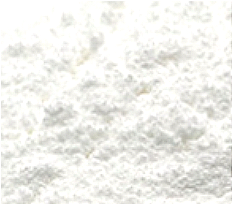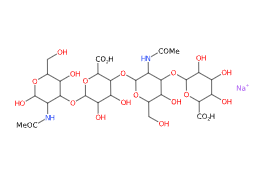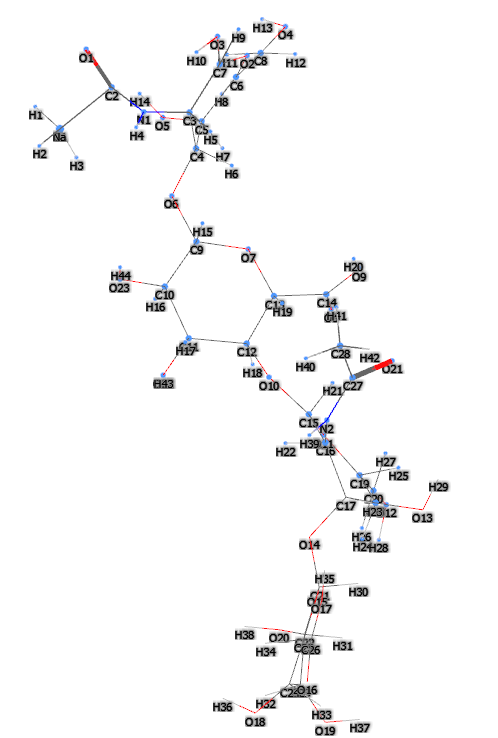| "Descrizione" by FRanier (9974 pt) | 2023-Dec-09 21:26 |
Review Consensus: 10 Rating: 10 Number of users: 1
| Evaluation | N. Experts | Evaluation | N. Experts |
|---|---|---|---|
| 1 | 6 | ||
| 2 | 7 | ||
| 3 | 8 | ||
| 4 | 9 | ||
| 5 | 10 |
Hydrolyzed Sodium Hyaluronate is a chemical compound, polysaccharide, sodium salt of hyaluronic acid. Hyaluronic acid is a natural substance produced by the human body and found in connective tissues such as skin and cartilage, in connective, epithelial and neural cells. It can be extracted from animals. Hydrolyzed is the process of hydrolysis a chemical reaction in which water is involved.
The name describes the structure of the molecule:
- Hydrolyzed indicates that the compound has undergone hydrolysis, a chemical process that breaks down molecules into smaller fragments by adding water. Hydrolysis makes the compound more easily absorbable by the skin.
- Sodium Hyaluronate refers to the sodium salt of hyaluronic acid, a natural polysaccharide found in human connective tissue. Hyaluronic acid is known for its hydrating and water-retention properties.
Raw Materials and Their Functions
Sodium Hyaluronate. A sodium salt of hyaluronic acid, a natural polysaccharide found in the connective tissue of organisms. It is known for its hydrating and viscoelastic properties.
Enzymes. Used to hydrolyze sodium hyaluronate, reducing the size of its molecules and enhancing its ability to penetrate the skin.
Industrial Chemical Synthesis of Hydrolyzed Sodium Hyaluronate
- Hydrolysis. The process begins with the enzymatic hydrolysis of sodium hyaluronate. Enzymes break down the polysaccharide bonds, reducing the molecular size of sodium hyaluronate.
- Reaction Control. The hydrolysis reaction is monitored to ensure it occurs correctly and the final product has the desired molecular size and properties.
- Purification. After hydrolysis, hydrolyzed sodium hyaluronate is purified to remove impurities and by-products.
- Quality Control. The purified hydrolyzed sodium hyaluronate undergoes quality checks to ensure it meets the required standards. After quality control, it is packaged for use in cosmetic and skincare products, where it utilizes its hydrating properties and enhances skin texture.
It takes the form of a white powder. Stable. Incompatible with strong oxidising agents.

What it is used for and where
Hydrolyzed Sodium Hyaluronate is used in cosmetic products as a moisturizing and anti-aging agent. It is valued for its ability to penetrate deeper into the skin compared to non-hydrolyzed hyaluronic acid, providing hydration and helping to reduce the appearance of fine lines and wrinkles.
Medical
Used in medicine as a protector in cases of injury to internal organs. It can alleviate inflammation of synovial tissue, strengthen the function of lubrication and viscosity of joint fluid, protect joint cartilage. It can improve intestinal function and protect the gastric mucosa.
Cosmetics
Wetting agent, moisturising, can reduce wrinkles by reinforcing nutrients in the skin or added through creams or lotions. Used in toothpastes as a protective agent.
Typical commercial product characteristics Sodium Hyaluronate
| Appearance | White powder |
| Boiling Point | 791.6ºC |
| Flash Point | 432.5ºC |
| Density | 1.78g/cm3 |
| pH | 6.0~7.5 |
| Bulk density | ≥0.2g/cm³ |
| Ignition residue | ≤20% |
| Loss on drying | ≤10% |
| Transparency | ≥99.0% |
| Absorbance | ≤0.24 |
| Glucuronic acid | 47.0%~52.0% |
| Protein | ≤0.1% |
| Heavy metals | ≤19ppm |
| Arsenic | ≤2ppm |
| Total bacterial | ≤100CFU/g |
| Yeasts & mold | ≤20CFU/g |
| PSA | 399.71000 |
| Nitrogen | 3.0-4.0% |
 |  |
- Molecular Formula C28H44N2NaO23+
- Molecular Weight 799.641 g/mol
- Exact Mass 799.22300
- CAS 9067-32-7
- EC Number:618-620-0
- UNII YSE9PPT4TH
- DSSTox Substance ID
- IUPAC sodium;(2S,3S,4S,5R,6R)-6-[(2S,3R,4R,5S,6R)-3-acetamido-2-[(2S,3S,4R,5R,6R)-6-[(2R,3R,4R,5S,6R)-3-acetamido-2,5-dihydroxy-6-(hydroxymethyl)oxan-4-yl]oxy-2-carboxy-4,5-dihydroxyoxan-3-yl]oxy-5-hydroxy-6-(hydroxymethyl)oxan-4-yl]oxy-3,4,5-trihydroxyoxane-2-carboxylic acid
- InChI=1S/C28H44N2O23.Na/c1-5(33)29-9-18(11(35)7(3-31)47-25(9)46)49-28-17(41)15(39)20(22(53-28)24(44)45)51-26-10(30-6(2)34)19(12(36)8(4-32)48-26)50-27-16(40)13(37)14(38)21(52-27)23(42)43;/h7-22,25-28,31-32,35-41,46H,3-4H2,1-2H3,(H,29,33)(H,30,34)(H,42,43)(H,44,45);/q;+1/t7-,8-,9-,10-,11-,12-,13+,14+,15-,16-,17-,18-,19-,20+,21+,22+,25-,26+,27-,28-;/m1./s1
- InChl Key YWIVKILSMZOHHF-QJZPQSOGSA-N
- SMILES CC(=O)NC1C(C(C(OC1O)CO)O)OC2C(C(C(C(O2)C(=O)O)OC3C(C(C(C(O3)CO)O)OC4C(C(C(C(O4)C(=O)O)O)O)O)NC(=O)C)O)O.[Na+]
- MDL number MFCD01773053
- PubChem Substance ID 24895688
- NACRES NA.25
- RTECS MT7250000
Synonyms
- Hyaluronate Sodium
- Hyalurone sodium
- Healon
- Hyaluronic acid, sodium salt
- Synacid
- Hyaluronic acid sodium
- Hyalgan
- Equron
- Nrd101
- Monovisc
- Hyaluronsan
- Nidelon
- Hyaluronan
- Orthovisc
- Suvenyl
- Ostenil
- Hyasol
- Provisc
- Hyladerm Khionat
- Sinovial
- (2S,3S,4R,5R,6R)-6-(((2R,3R,4R,5S,6R)-3-acetamido-2,5-dihydroxy-6-(hydroxymethyl)tetrahydro-2H-pyran-4-yl)oxy)-3-(((2S,3R,4R,5S,6R)-3-acetamido-4-(((2R,3R,4S,5S,6S)-6-carboxy-3,4,5-tri
- Supartz
| Evaluate |

